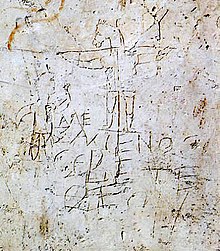 |
| The Alexamenos graffito |
images wikimedia
Wikipedia tells
The Alexamenos graffito (also known as the graffito blasfemo) is an inscription carved in plaster on a wall near the Palatine Hill in Rome, now in the Palatine Antiquarium Museum. It is alleged to be among the earliest known pictorial representations of the Crucifixion of Jesus, together with some engraved gems.Read the entire article from wikipedia
The image depicts a human-like figure affixed to a cross and possessing the head of a donkey.
In the top right of the image is what has been interpreted as either the Greek letter upsilon or a tau cross.
To the left of the image is a young man, apparently intended to represent Alexamenos, a Roman soldier/guard, raising one hand in a gesture possibly suggesting worship.
Beneath the cross is a caption written in crude Greek: Αλεξαμενος ϲεβετε θεον. ϲεβετε can be understood as a variant spelling (possibly a phonetic misspelling) of Standard Greek ϲεβεται, which means "worships". The full inscription would then be translated as "Alexamenos worships [his] God". Several other sources suggest "Alexamenos worshipping God", or similar variants, as the intended translation.
No clear consensus has been reached on when the image was made. Dates ranging from the late 1st to the late 3rd century have been suggested, with the beginning of the 3rd century thought to be the most likely.
The graffito was discovered in 1857 when a building called the domus Gelotiana was unearthed on the Palatine Hill. The Emperor Caligula had acquired the house for the imperial palace, which, after Caligula died, became used as a Paedagogium (boarding school) for the imperial page boys. Later, the street on which the house sat was walled off to give support to extensions to the buildings above, and it thus remained sealed for centuries.

No comments:
Post a Comment